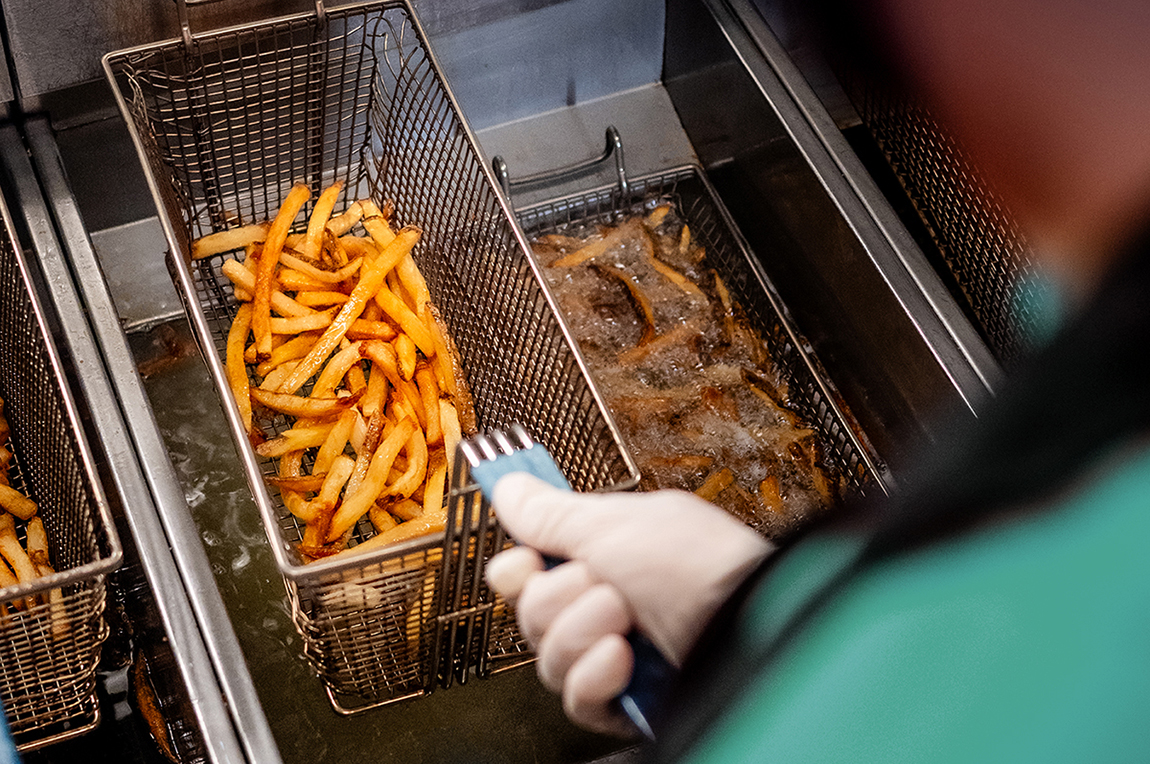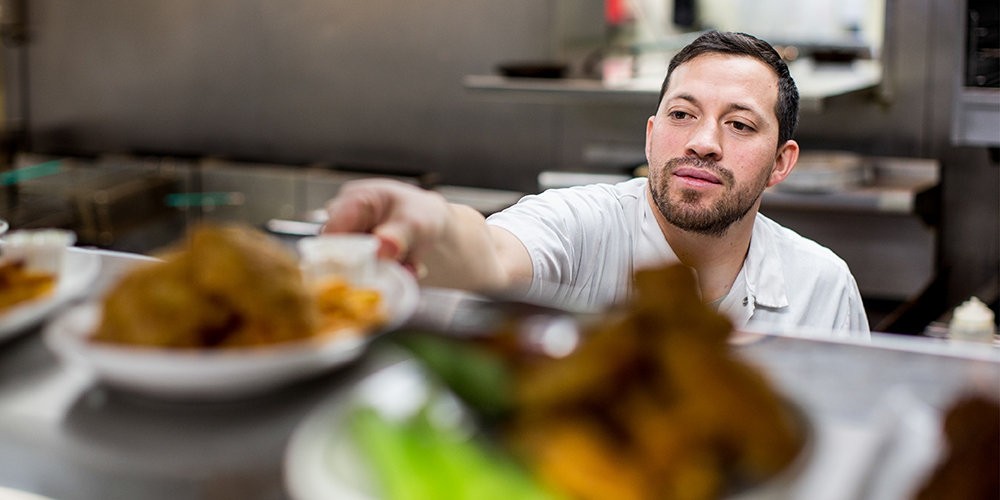Advancements in handling and distribution of waste oil in the supply chain are reshaping the landscape for producers working to turn fry oil into fuel.
By Luke Geiver | September 20, 2010
RTI’s automated removal system removes the waste oil through one hose, while fresh oil is supplied by another hose, all without entering the site. illustration: RTI INC.
Restaurant Technology Inc. has automated the worst job at the restaurant, according to Jeff Kiesel, CEO of RTI, and business, he says, is good. For 10 years RTI has been collecting waste cooking oil from more than 50 cities and now the Minnesota-based company has 36 operating waste oil depots optimized for biodiesel producers, with more on the way. The system “is a more sophisticated way for people to manage their cooking oil,” Kiesel says. The advanced system, which features everything from computer tracking and analysis of waste-oil use, to a customized, patented design on all oil removal and transportation vehicles, is not alone, however, in the new world of waste cooking oil infrastructure and supply.
In a different time, securing a sufficient amount of waste oil feedstock was one thing, but finding an economical distribution network or pick-up system was a completely different obstacle many producers struggled to overcome. Led by companies such as RTI, the waste cooking oil supply chain is now an efficient, effective and, for some, an ever-emerging industry unaffected by tax credits or government mandates. Today, the waste oil collection and distribution industry remains mostly affected by what Kiesel refers to as the dirty part of the job: grease.
The Supply System
Picking up waste cooking oil from the local college cafeteria or the nearest fast-food joint no longer involves large open air containers or undependable supply-at least it doesn’t have to. All across the country there are cooking oil distributors and extraction teams utilizing state-of-the-art systems based on vacuum trucks and computer-based recordkeeping. In New York, Tri-State Biodiesel collects oil from over 2,000 locations using specialized trucks. In Atlanta, Southern Green Industries collects waste oil specifically, and only, for biodiesel, and Orlando has a new waste oil extraction company as of March, FiltaBio, that will serve Florida and the rest of the country.
Even with the growing number of extraction companies throughout the U.S., Kiesel says the producers still have one concern about the grease. “Producers,” he says, “want a clean, quality grease.” To get it, they have to look no further than the likes of Tri-State or RTI, but as the saying goes, everyone’s different. Pinning down the best may be impossible given the producers’ range of needs, but any company similar to RTI could make the case that its system is at the top. Here’s why.
RTI was initially formed around bulk CO2 tank distribution, but Kiesel says as the company evolved, the RTI team wanted to figure out a way to distribute cooking oil in bulk. To do so, the team emphasized owning both the equipment and technology used for the service. Now Kiesel says, “We have to tell the story of our value, efficiency, safety and cleanliness, all of which are key things that our customers are looking for.”
The system incorporates both waste oil extraction and fresh oil supply to restaurants, coupled with a software program for tracking the amount of grease used at each location. According to RTI, most restaurants bring in oil packaged in 35- or 50-pound containers, and a location that uses 400 pounds of oil per week generally unloads and stores 590 35-pound containers per year. What does this mean? For Kiesel it means a greater chance for spills, but more importantly, a sacrifice to the way waste oil is presented to biodiesel producers. “Our waste cooking oil never gets exposed to the outside elements,” he says.
To avoid the elements, the system directly connects the fryers at a facility to internal storage tanks (capacity determined by each specific location) for both waste and fresh oil. When the used oil’s time is up, the system automatically draws the oil into the waste oil holding tank, and, with the flip of a switch, a restaurant employee can refill the fryer with new oil. An RTI website tracks the amount of oil used at each facility, and when it’s time for more, the trucks head to the location. “Our trucks carry between two and four different types of fresh oil and each truck carries a tank of waste oil,” Kiesel says. Upon arrival in a patented cooking oil truck, an RTI employee can hook up a vacuum hose attached to the truck, to an external port at the restaurant and remove the waste oil from the waste holding tank in fifteen minutes or less. To avoid any mix-ups, the hoses are coupled differently, preventing waste oil from entering into the fresh oil tank and vice versa. During the process, the RTI employee doesn’t require any help from the facility’s employees, and they don’t even need to enter the building. Once the oil extraction has taken place, the driver then takes the waste oil to a specialized depot.
While the extraction method used by RTI is a major plus for producers seeking waste oil, the depots are what Kiesel says the biodiesel plants find most appealing. “The producers like the fact they can go get full containers worth of product. Going in and getting 40,000 pounds of used cooking oil in one shot is a benefit,” he says. “It is a very predictable supply.” Upon arriving at a depot, producers can hook right into the 20,000- to 25,000-pound holding tanks via hose and take what they need. Some waste oil haulers come in everyday, Kiesel notes.
As an indication of how effective and dependable RTI’s system is, look at Renewable Energy Group Inc. In July, REG signed a long-term contract with RTI, giving REG access to all of RTI’s yellow grease helping to further “the green story” of RTI, according to Kiesel. Even though REG signed a long-term contract, Kiesel says there are month-to-month contracts, but the producer has to have good credit. To highlight the dependability of supply, RTI’s customer retention rate with restaurants is greater than 97 percent, “and the 3 percent we lose happens because restaurants go out of business,” Kiesel says.
Not all waste oil providers use the depot system, however. Some, like Southern Green Inc., bring the oil directly to the producers. “The oil coming out of most restaurants is not exactly ready for direct conversion to biodiesel,” says Rob Del Bueno, managing partner for SGI. Because most producers have some practical limits on FFA and moisture, SGI pretreats the oil to meet specifications required by partner producers. After treatment, the oil is bulked into tanker loads and delivered, according to Del Bueno. “We determined that being a part of the recycled content feedstock supply chain was a good fit for us,” Del Bueno says, “and an essential piece in both the environmental and economic sustainability of biodiesel.”
The Middleman
Aside from the extraction sector of the waste oil supply chain, there are also companies like SLM Waste. Susan Daywitt, CEO of SLM, says, “I don’t own any trucks. I manage services.” SLM acts as the “middle person between the vendor and the client,” says Daywitt. For example she says, “We met up with Chipotle Mexican Grill and every one of their locations wanted a measure to remove cooking oil.” So, SLM coordinates the oil removal from the vendor, in this case, Chipotle, and supply’s a client, in most cases, a biodiesel producer, with the oil commodity. “Every entity that we work with out there has some kind of biodiesel product and about 96 percent of what I pick up for cooking oil is converted to biodiesel.”
The fact that SLM Waste doesn’t own or operate trucks, hoses or depots, isn’t a bad thing to Daywitt. “Where I benefit greatly is in the volume of locations because,” she says, “I don’t take on accounts unless they are likely fifty locations and above.” Typically, SLM benefits from operating as a volume entity. Rather than work on the removal side of the supply chain, SLM focuses on securing the McDonald’s and Wendy’s of the world to provide her clients with a dependable and quality amount of cooking oil, leaving the extraction and transport to companies contracted through SLM. Part of that focus also means looking for vendors with the same values. SLM is trying to make the environment more sustainable, says Daywitt, and doing so means working with companies that are for biodiesel. “I’m finding that there are enough companies out there that are supporting this value.”
Because of this support, Daywitt says her business model is not affected by tax incentive expirations currently seen in the biodiesel industry. For SLM, there will always be enough French fries to create an ample amount of feedstock for producers, or, whoever else wants to buy the oil. However, for Del Bueno, who works more directly with producers, the tax credit issue has presented more of a challenge to SGI’s survival in the waste cooking oil supply chain. “The tax credit situation coupled with low crude prices has certainly put the squeeze on producers, but we have been fortunate to be able to identify producers,” he says, “who have been able to meet us somewhere in the middle, economically speaking.”



